Humphrey’s Unsolicited Ad Hock Visitor
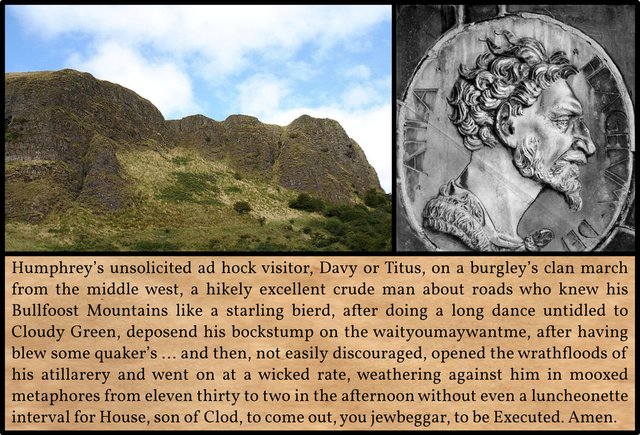
The last ten pages of Chapter 3 of James Joyce’s Finnegans Wake comprise an episode known as The Battery at the Gate. The third and final section of the Battery, Herr Betreffender (RFW 055.01–059.28), is yet another account of the Oedipal Event. In the previous paragraph HCE suffered an assault at the hands of an Austrian salesman, who was spending his summer holidays as a guest in HCE’s inn. Believing that the landlord has relieved him of a sum of money and rifled the pockets of his overcoat, he proceeded to batter on HCE’s gate and demand retribution. In the present paragraph this individual has unexpectedly morphed into an American, but continues to press home his attack at the gate of HCE’s establishment.
In the first edition of Finnegans Wake (1939), this metamorphosis takes place abruptly in the middle of a paragraph, but in The Restored Finnegans Wake (2010) Danis Rose & John O’Hanlon have reinstated a paragraph break between the Austrian and American incarnations of HCE’s attacker. This paragraph break was introduced by Joyce at draft-level 8 but disappeared when the book was being typeset.
First-Draft Version
The first draft of this passage followed the previous section without a break and consisted of just two sentences:
Humphrey’s unsolicited visitor said through the gate first that he would break his head next that he would then break the gate over his head and finally give him his (Humphrey’s) blood to drink. He kept abusing him from ten thirty till one in the afternoon without a lunch interval. ―Hayman
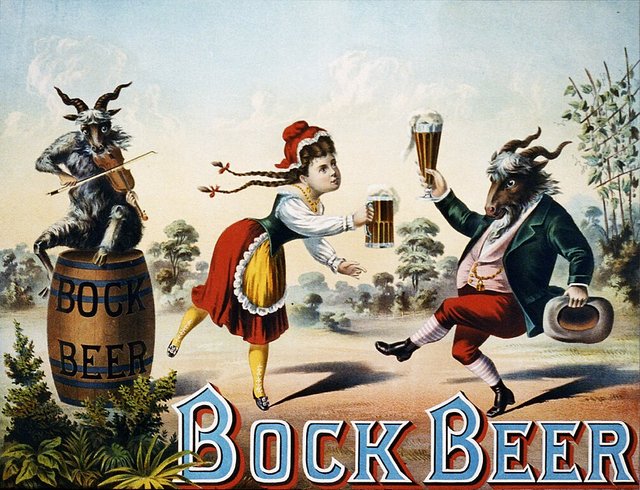
In expanding this to half a page, Joyce not only Americanized HCE’s assailant but also elaborated the food-and-drink motif that was already present in the first draft. The second draft altered the second sentence to read:
He demanded drink and kept abusing him ...
In the real world of Finnegans Wake―insofar as there is a real world in Finnegans Wake―it is possible that the whole incident of the Battery at the Gate is simply a dreamlike episode conjured up in the mind of the sleeping landlord of the Mullingar House by the noise of a late-night reveller, who has arrived at the pub after closing time and is battering on the door, demanding drink. This would account for the prominence given to food and drink in the final version of this paragraph.
bockstump German: Bock, a dark German lager : French: bock, glass of beer : a beer glass. Bock is the German for ram, which may account for bleated two lines below.
some quaker’s (for you! Oates!) Quaker Oats, an American company famous for its oatmeal or porridge. Titus Oates was an English Anglican priest who fabricated the Popish Plot in 1678, alleging that several prominent Catholics were conspiring to assassinate Charles II. Among those named was Peter Talbot, Archbishop of Dublin. Titus was also the nickname of Lawrence Oates, who accompanied Robert Scott to the South Pole in 1912. He famously walked out of the tent in a blizzard, saying: I am just going outside and may be some time. He was never seen again. The Irish Antarctic explorer Ernest Shackleton was a Quaker.
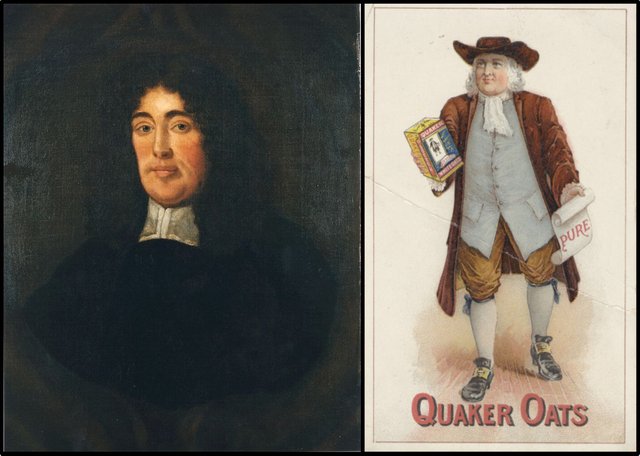
heeltapper a heeltap is a small amount of drink (especially alcoholic) remaining at the bottom of a glass.
stirabouter In Ireland porridge was once popularly known as stirabout, though the term is rarely heard nowadays. Joyce used it in this sense in The Dead. The Oxford English Dictionary describes the word as Originally Anglo-Irish. The word also means a bustling person.
thickerthanwater (Proverbial) Blood is thicker than water, meaning that familial ties are stronger than other relationships, such as those between friends or colleagues. The Blood of Christ is drunk during the Catholic Mass, an example of the Mastication of the Host, an important leitmotif in Finnegans Wake.
steppebrodhar Danish: brød, bread. Coming immediately after the reference to blood, this bread is clearly the Body of Christ. For the other elements in this word see below.
wood alcohol Methanol or methyl alcohol. This is highly toxic (taxis) to humans, and even small amounts can cause permanent blindness, so it can hardly be described as a drink. But alcohol generally refers to the closely related chemical ethanol, which is the active ingredient in potable alcohol.
his isbar HCE’s stuttering attempt at his bar. Also Russian: izba, cottage : Polish (archaic): izba, room. In Finnegans Wake stuttering is a sign of guilt.
public a pub or public house. Joyce referred to Chapter II.3 as The Scene in the Public.
oven
sake Japanese: sake [酒], alcoholic beverage : rice wine. It is traditionally served in a rectangular wooden vessel called a masu.
irsk irskusky Irish whiskey : Irish: uisce, water. More stuttering.
luncheonette a small diner that serves lunch
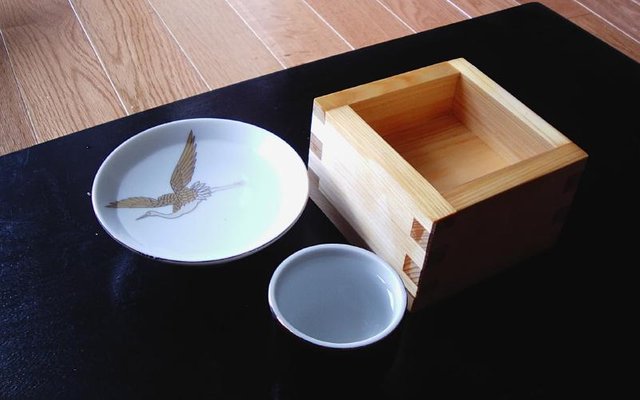
Shem & Shaun
The Battery at the Gate is another telling of the Oedipal Event, in which HCE is confronted by a younger man embodying his two sons, Shem & Shaun. John Gordon is probably right, then, when he detects traces of HCE’s sons in Herr Betreffender. As I have pointed out before, Shem is often associated with Australia and Shaun with America. Australia is a hot and hellish underworld, an appropriate place for the diabolical Shem : America is the Promised Land, making it a suitable abode for the angelic Shaun. If we take Austria [Eastern] as a dream-distortion of Australia [Southern], then we can begin to see why Herr Betreffender’s nationality changes during this episode. He embodies both sons.
Gordon also believes that the door of the master bedroom in the Mullingar House is the focal point of Shem & Shaun’s Oedipal threat to their father. While HCE and ALP are locked in sexual congress―conceiving Issy?―the two brothers are at the door trying to spy on them and figure out just what it is that mummies and daddies do behind closed doors. Shaun, whose eyesight is good, is peering through the keyhole : Shem, whose hearing is good, is listening at the door.
Shem & Shaun are the quintessential sibling rivals. As such they are often played in Finnegans Wake by a mythical or historical pair of warring twins: Romulus & Remus, Cain & Abel, Jacob & Esau. Sometimes they appear as rivals who were not actually brothers, but closely related in some other fashion: Brutus & Cassius, for instance.
In this paragraph we have an example of each: Attila & Bleda : Brian Boru & Brodir:
his bleday steppebrodhar ... his atillarery
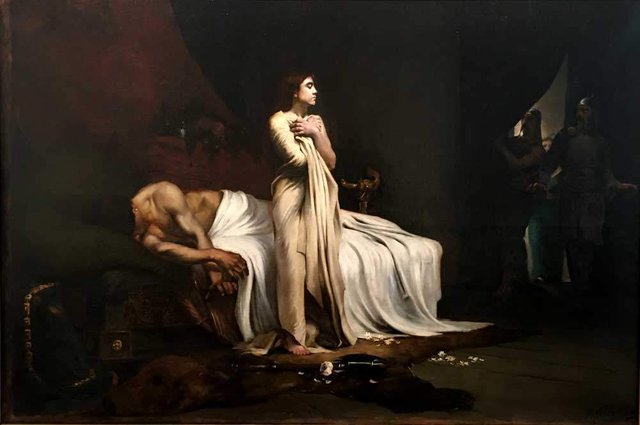
Attila the Hun needs no introduction. In the 5th century this warlord from the steppes of Central Asia led the Huns into Europe and threatened to conquer Roman Gaul, before being halted at the Battle of the Catalaunian Fields in 451. The latter, you may recall, was alluded to on the opening page of Finnegans Wake (oystrygods gaggin fishygods, referring to the fact that in the battle the Ostrogoths sided with Attila and the Visigoths with Rome). Attila and his elder brother Bleda succeeded their uncle Rugila and ruled jointly over the Huns from 435 until the death of Bleda in 445. By all accounts there was no love lost between the two. It is alleged that Attila killed Bleda after Bleda tried to kill him. Attila, himself, is said to have died on his wedding night after a day of excessive drinking, so he is quite at home in the pages of Finnegans Wake.
Brodir was the name of a Norse warlord who took part in the Battle of Clontarf, outside Dublin, in 1014. This battle was the culmination of a revolt against Brian Boru, High King of Ireland, by Máel Mórda mac Murchada, King Leinster, and Sitric Silkenbeard, King of Dublin. According to tradition, Brodir and Brian met on the battlefield and died at each other’s hands. By a happy coincidence, Brodir had a brother, Ospak of Man, who fought on Brian’s side at Clontarf.
Note that the Oedipal Figure can also be recognized as HCE himself, who is, as usual, his own worst enemy. This is indicated explicitly by the description of the visitor as a hikely excellent crude man, which encodes the familiar HCE initialism. At the end of this paragraph we have further confirmation of this close relationship between offender and defender:
House, son of Clod, to come out, you jewbeggar, to be Executed.
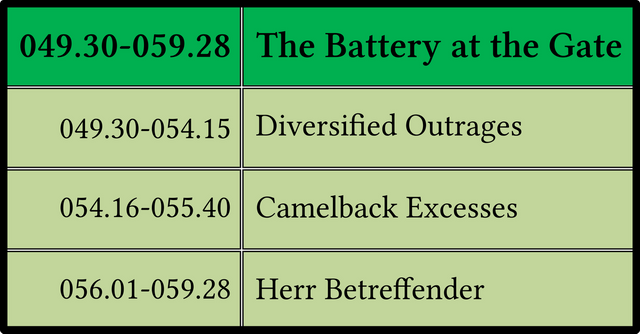
Music Again
Like the preceding paragraph, this one contains a cluster of allusions to Irish songs taken from Charles Villiers Stanford’s Complete Collection of Irish Music as Noted by George Petrie. FWEET identifies seven titles:
clan march Ancient Clan March
a hikely excellent crude man about road The highly excellent good man of Tipperoughny
his Bullfoost Mountains The Belfast Mountain
a starling bierd Alas, that I’m not a little starling bird
a long dance Long Dance
Cloudy Green Adieu ye young men of Claudy green. Claudy or Clady is a village in County Derry.
the tairor of his clothes The taylor of the cloth
Finally, two honorary mentions:
the houseking’s ... crack a nut E T A Hoffmann’s Christmas tale The Nutcracker and the Mouse King was famously set to music by Tchaikovsky as his ballet The Nutcracker.
his granfather’s My Grandfather’s Clock, a popular American song by Henry Clay Work.
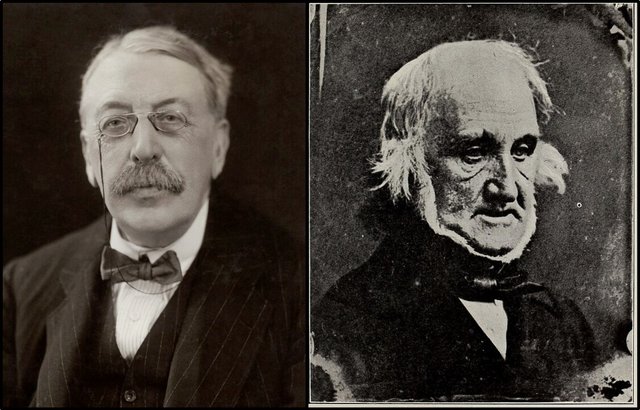
Buckley & Kersse
In Chapter II.3, The Scene in the Public, two epic reenactments of the Oedipal Event will take place:
How Kersse the Tailor Made a Suit of Clothes for the Norwegian Captain
How Buckley Shot the Russian General
Both of these are very briefly foreshadowed in the present paragraph:
a burgley’s ... the tairor of his clothes ... the hirsuiter
Although the assassination of the Russian General during the Crimean War is not specifically mentioned here, we do have the following allusion to Russian politics:
... he would break his bulsheywigger’s head for him ...
- bulsheywigger’s Bolshevik’s
Davy or Titus
In this paragraph HCE’s visitor is identified as Davy or Titus. Who do these names refer to?
FWEET suggests that Davy is Humphry Davy, the English chemist who invented the Davy lamp. This Davy is mentioned immediately after Humphrey’s, so who knows? But Adaline Glasheen notes that David, by way of the Welsh St David, becomes Taff (Glasheen 44, 69). Butt & Taff are the two soldiers who reenact How Buckley Shot the Russian General in the Crimea. In the same line as Davy we have a clear allusion to Buckley (burgley’s), so this seems more likely than Humphry Davy.
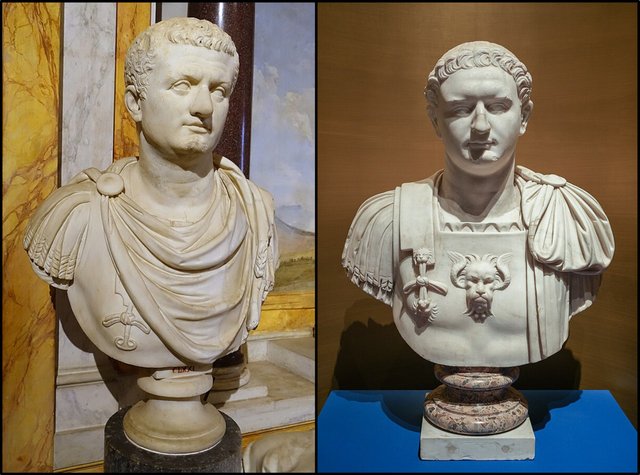
Glasheen also suggests that Titus refers to the eponymous hero of Titus Andronicus, Shakespeare’s melodramatic drama. This play features cannibalism, which could feed into the food-and-drink theme in this paragraph. Titus Oates also includes a foody element in his surname.
FWEET once again disagrees, suggesting that Titus refers to the Roman Emperor (the umperon’s) Titus Vespasianus. The latter had a younger brother, Domitian, who succeeded him. There is no evidence that the brothers ever quarrelled or threatened their father Vespasian. But Domitian was embarrassed enough by his baldness to wear a wig (busheywigger’s).
Closing Time
The original draft of this paragraph already included a timestamp:
He kept abusing him from ten thirty till one in the afternoon without a lunch interval.
This supports the hypothesis that someone is banging on the door of the Mullingar House after closing time. According to the Intoxicating Liquor (General) Act, 1924, the closing time on weekdays was 10 o’clock. In the final version, HCE’s attacker claims that the clock is fast―a common practice in Irish pubs―and that it is just gone 10 o’clock:
alleging that his grandfather’s was all taxis and that it was only after ten o’connell
grandfather’s My Grandfather’s Clock
taxis Ancient Greek: ταχύς (tachýs), fast. Compare this with the Cad Encounter, where the Cad complains that his watch is bradys: Ancient Greek: βραδύς (bradús), slow (RFW 028.16).
o’connell O’Connell’s Dublin Ale, brewed by The Phoenix Brewery in James’s Street, Dublin. The brewery was once owned by Daniel O’Connell, son of the Liberator. It is not to be confused with the Phoenix Park Distillery in Chapelizod, where Joyce’s father worked for a time.
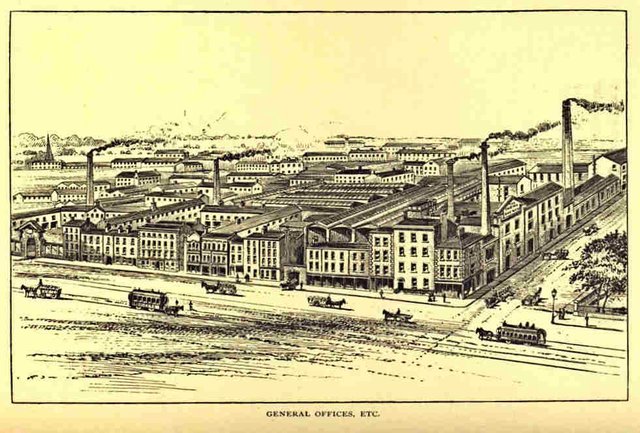
In the final version Joyce has also altered the times between which HCE’s attacker berates him:
and went on at a wicked rate, weathering against him in mooxed metaphores from eleven thirty to two
Here we have the familiar 1132, which symbolizes the Fall and Resurrection of Man in Finnegans Wake.
- mooxed metaphores Not only mixed metaphors (French: métaphores, metaphors) but also an allusion to yet another version of the Oedipal Event: Shaun’s parable of The Mookse and the Gripes in I.6, The Quiz. The matching gripes is at RFW 058.05.
And that’s as good a place as any to beach the bark of our tale.
References
- Joseph Campbell, Henry Morton Robinson, A Skeleton Key to Finnegans Wake, Harcourt, Brace and Company, New York (1944)
- Adaline Glasheen, Third Census of Finnegans Wake, University of California Press, Berkeley, California (1977)
- David Hayman, A First-Draft Version of Finnegans Wake, University of Texas Press, Austin, Texas (1963)
- James Joyce, Finnegans Wake, The Viking Press, New York (1958, 1966)
- James Joyce, James Joyce: The Complete Works, Pynch (editor), Online (2013)
- Danis Rose, John O’Hanlon, The Restored Finnegans Wake, Penguin Classics, London (2012)
Image Credits
- Cave Hill, Belfast Mountains: © Donna (photographer), Creative Commons License
- Attila the Hun: Louvre Museum, Paris, Public Domain
- Bock: Calvert Lithographing Company, Detroit, Michigan : Library of Congress, Prints & Photographs Division, Washington, DC (1882), Public Domain
- Titus Oates: Godfrey Kneller (artist), University of Cambridge, Cambridge, England, Public Domain
- Quaker Oats: Miami University Library, Digital Collections, Public Domain
- Japanese Sake: The Epopt (photographer), Public Domain
- The Death of Attila: J. Villeclère (artist), Musée des Beaux-Arts de Nice, Nice, France, Public Domain
- Charles Villiers Stanford: Alexander Bassano (photographer), National Portrait Gallery, London, Public Domain
- George Petrie: The Journal of the Royal Society of Antiquaries of Ireland, Volume 46 (Consecutive Series), Plate V, Dublin (1917), Public Domain
- Titus: Daderot (photographer), Galleria Borghese, Rome, Public Domain
- Domitian: Castro Pretorio (photographer), National Archaeological Museum, Naples, Public Domain
- The Phoenix Brewery, Dublin: Alfred Barnard, The Noted Breweries of Great Britain and Ireland, Volume 3, Page 68, Sir Joseph Causton & Sons, London (1890), Public Domain
Useful Resources
- FWEET
- Jorn Barger: Robotwisdom
- Joyce Tools
- The James Joyce Scholars’ Collection
- FinnegansWiki
- James Joyce Digital Archive
- John Gordon’s Finnegans Wake Blog
